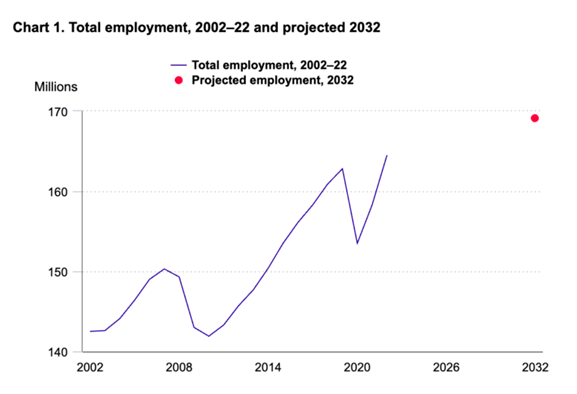By: Pierrelyne D. | April 08, 2024
In the intricate web of economic forecasts and projections, understanding the underlying trends is paramount. The Bureau of Labor Statistics (BLS) provides invaluable insights into the future of employment through its comprehensive projections. As we delve into the dynamics shaping the job market from 2022 to 2032, it becomes evident that demographic shifts play a pivotal role in driving these forecasts.
The job outlook in biotechnology is promising, with an anticipated 5% employment growth from 2022 to 2032, faster than the average for all occupations, as reported by the U.S. Bureau of Labor Statistics, Employment Projections program(1). This growth is driven by the increasing demand for biological and medical research, particularly in areas such as synthetic biology and biotechnology research and development projects. The U.S. Bureau of Labor Statistics also projects about 10,600 job openings for biological technicians each year over the next decade(2.”Chart 1”).

Impact of Mergers and Acquisitions (M&As)
Mergers and acquisitions (M&As) represent pivotal moments within the biotech industry, influencing both its workforce and overall dynamics. These transactions evoke a spectrum of emotions and concerns among employees, ranging from optimism about financial gains and career advancement for shareholders to apprehension, particularly among support staff and executives, regarding job security.
For employees holding shares, M&As often present opportunities for financial gains through stock options and the potential for enhanced career growth within the newly merged or acquired entity. However, this positive outlook contrasts with the uncertainty experienced by other segments of the workforce, particularly support staff and executives, who may fear job displacement or organizational restructuring resulting from M&A activities.
The impact of M&As extends beyond individual job security concerns and permeates the broader biotech talent pool. These transactions often trigger workforce realignments, restructuring initiatives, and talent migrations as companies consolidate operations, rationalize resources, and adapt to new strategic priorities post-M&A.
Consequently, the talent landscape within the biotech industry undergoes significant shifts, with implications for recruitment, skill requirements, and professional development pathways.
Employment Challenges in 2023

The past year saw a 57% increase in job layoffs in the biotech sector compared to 2022(3), which impacted both young Biotech and big Pharma companies. This surge in layoffs has impacted both emerging biotech companies and established pharmaceutical firms, indicating widespread challenges across the sector.
The several reasons behind the uptick in layoffs, including funding shortages, revenue losses, and broader economic uncertainties. These factors have likely compelled companies to restructure their operations, streamline costs, and adjust their workforce sizes in response to financial pressures and market conditions.
Despite the grim outlook painted by the rise in layoffs, it is also a glimmer of hope for the industry.
Future Projections
The trend of biotech companies announcing plans for expansion and the creation of additional jobs has been evident since the onset of 2022, signifying the industry's robust growth trajectory.Companies have the responsibility to address concerns during the interview process, and due to financial liquidity challenges, the market may not see a full rebound until 2025-2026.

The biotech sector does indeed face challenges such as layoffs resulting from funding shortages and economic downturns, which can impact short-term job prospects. However, the industry is generally expected to experience significant growth in the long term due to factors such as continuous innovation, technological advancements, and increasing demand for biotech products and services. Additionally, mergers and acquisitions (M&As) play a significant role in shaping the job outlook in biotechnology, as they can lead to workforce restructuring, changes in company strategies, and new opportunities for employment. Despite the short-term disruptions that M&As may cause, they often contribute to the industry's overall growth and evolution.
In summary, M&As exert a profound influence on the biotech job market, eliciting diverse reactions and perceptions among employees while simultaneously reshaping the industry's talent ecosystem. Understanding and navigating these complexities is essential for stakeholders to effectively manage workforce transitions and capitalize on emerging opportunities within the evolving biotech landscape.
REFERENCE
1. US Bureau of Labor Statistics, Occupational Outlook Handbookhttps://www.bls.gov/ooh/ life-physical-and-socialscience/biologicaltechnicians.htm#:~:text=Employment%20of% 20biological%20technicians%20is, on%20average%2C%20over%20the%20decade
2. US Bureau of Labor Statistics, Industry and occupational employment projections overview and highlights, 2022–32, https://www.bls.gov/opub/mlr/2023/article/industry-and-occupational-employment-projections-overview-and-highlights-2022-32.htm
3. Gabrielle Masson, Layoffs rise 57% YOY in a good, bad and ugly 2023 for biotech (cited 02 January 2024),
https://www.fiercebiotech.com/biotech/every-bad-signal-theres-good-sign-not-far-behind-biopharma-layoffs-rise-57-yoy-hope-2024
